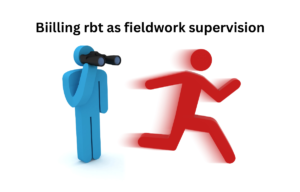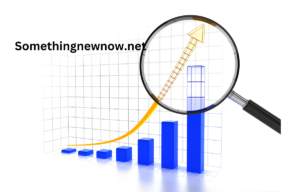Home affordability is a consideration for anyone looking to purchase a property. The factors that influence how much home you can afford is essential to making a sound financial decision. From income and debt levels to mortgage rates and down payment amounts, various elements come into play when determining home affordability. We will explore the key factors that impact your ability to purchase a home, helping you navigate the complexities of the real estate market with confidence.
When assessing home affordability, several factors must be considered to you, you are making a financially sustainable choice. The primary factors include your income level, debt-to-income ratio (DTI), credit score, down payment, and the current mortgage interest rates.
Income Level: Your gross income is the starting point for determining how much home you can afford. Lenders use your income to calculate the maximum loan amount you can qualify for. The higher your income, the more you may be able to borrow, assuming your other financial factors are in line.
Debt-to-Income Ratio (DTI): This is the percentage of your gross monthly income that goes toward paying debts. Lenders use DTI to assess your ability to manage monthly payments and repay the money you intend to borrow. A lower DTI ratio indicates more room in your budget for housing expenses, making you a more attractive borrower.
Credit Score: Your credit score plays a significant role in determining the interest rate you will qualify for on a mortgage. Higher credit scores result in lower interest rates, reducing your monthly mortgage payments and increasing your home affordability.
Down Payment: The amount of money you can put down upfront on the purchase of a home directly impacts how much you can borrow and the type of mortgage you can qualify for. A larger down payment reduces the loan amount, potentially lowers your interest rate, and can eliminate the need for private mortgage insurance (PMI).
Mortgage Interest Rates: The current mortgage interest rates have a direct effect on your monthly payments and, consequently, on how much home you can afford. Lower rates mean lower payments and increased buying power, while higher rates can reduce affordability.
How Does Debt-to-Income Ratio Affect Your Home Buying Power?
Understanding Debt-to-Income Ratio (DTI)
The Debt-to-Income Ratio (DTI) is a key factor that lenders use to determine your home buying power. It is calculated by dividing your total monthly debt payments by your gross monthly income. A lower DTI ratio indicates that you have a manageable level of debt relative to your income, making you a more attractive candidate for a mortgage. Lenders prefer a DTI ratio of 43% or lower, though the exact requirements can vary depending on the lender and loan type.
Impact on Mortgage Approval and Loan Amount
Your DTI ratio directly impacts not only whether you qualify for a mortgage but also the amount you can borrow. A lower DTI ratio allows you to qualify for a larger loan, as it indicates to lenders that you have the financial stability to manage additional debt. A higher DTI ratio may limit the amount you can borrow or lead to higher interest rates, as lenders view you as a higher risk.
Strategies to Improve Your DTI Ratio
To enhance your home buying power, it is important to manage and reduce your DTI ratio before applying for a mortgage. Strategies include paying down existing debts, increasing your income, or refraining from taking on new debt. By improving your DTI, you can increase the likelihood of mortgage approval and potentially secure a better interest rate.
What Role Does Credit Score Play in Home Affordability?
Credit Score and Mortgage Interest Rates
Your credit score is one of the most critical factors in determining your mortgage interest rate, which in turn affects your home affordability. Lenders use your credit score to assess your risk level; a higher score generally qualifies you for lower interest rates, making your mortgage payments more affordable. On the other hand, a lower credit score can result in higher interest rates, increasing your monthly payments and reducing the amount of home you can afford.
Minimum Credit Score Requirements
While the minimum credit score required for a mortgage varies by lender and loan type, a score of 620 or higher is needed to qualify for most conventional loans. FHA loans may allow for lower scores, sometimes as low as 500 with a larger down payment, but this comes with trade-offs, including higher mortgage insurance premiums.
Improving Your Credit Score for Better Affordability
To increase your home affordability, work on improving your credit score before applying for a mortgage. This can be achieved by paying bills on time, reducing credit card balances, and avoiding new debt. Regularly checking your credit report for errors and disputing inaccuracies can also help boost your score, leading to better loan terms and greater purchasing power.
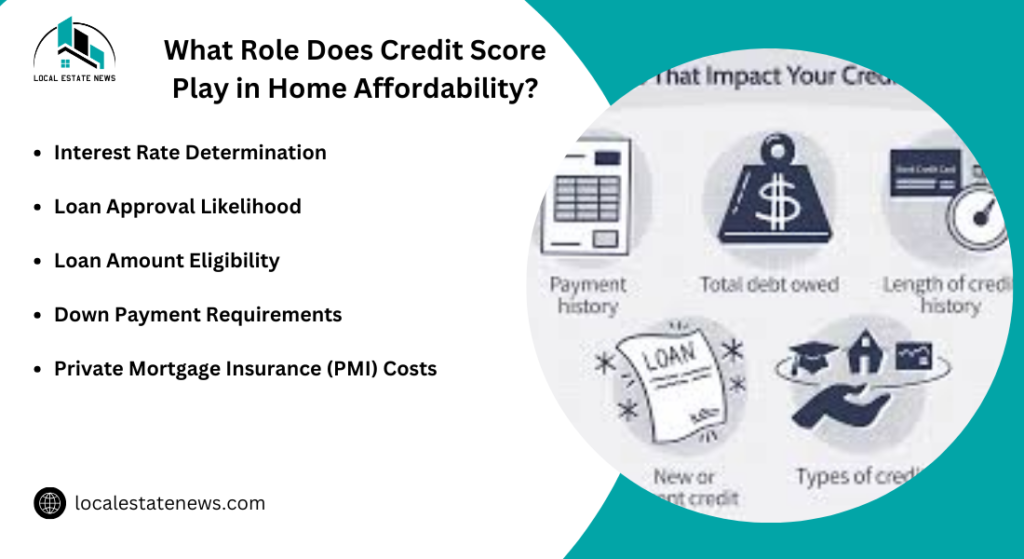
How Much Should You Save for a Down Payment?
The Impact of Down Payment Size on Affordability
The size of your down payment is a significant factor in determining your home affordability. A larger down payment reduces the loan amount, which in turn lowers your monthly mortgage payments and the total interest paid over the life of the loan. Putting down at least 20% can eliminate the need for private mortgage insurance (PMI), further reducing your monthly costs.
Minimum Down Payment Requirements
While the traditional recommendation is to save a 20% down payment, many loan programs allow for much lower down payments. For example, FHA loans require as little as 3.5% down, and some conventional loans may allow down payments as low as 3%. Smaller down payments usually come with higher interest rates and the added cost of PMI, which can impact your home affordability.
Strategies for Saving a Larger Down Payment
To maximize your home affordability, consider saving a larger down payment. This can be done by setting a savings goal, cutting unnecessary expenses, and taking advantage of down payment assistance programs if eligible. A larger down payment not only improves your affordability but also strengthens your offer in a competitive housing market.
By focusing on these factors DTI ratio, credit score, and down payment you can better navigate the complexities of home affordability and make informed decisions that align with your financial goals.
What is the Impact of Mortgage Rates on Home Affordability?
Mortgage Rates and Monthly Payments
Mortgage rates have a profound impact on home affordability, directly influencing the monthly mortgage payments a buyer must make. When mortgage rates rise, the cost of borrowing increases, leading to higher monthly payments. For example, if rates increase from 3% to 7%, a buyer might find their monthly payment on a typical mortgage significantly higher, potentially pricing them out of the home they could have afforded at a lower rate. Lower mortgage rates reduce monthly payments, thereby increasing a buyer’s purchasing power.
Interaction with Home Prices
Interestingly, mortgage rates and home prices are interconnected. Higher mortgage rates often lead to a cooling of the housing market, which can cause home prices to stabilize or even decline as fewer buyers can afford to purchase homes. This isn’t always enough to offset the affordability issues caused by higher rates. In some markets, even with a decline in prices, the higher cost of borrowing can still reduce affordability, particularly if wages and income levels have not kept pace.
Long-Term Affordability Considerations
When considering the impact of mortgage rates on home affordability, it is also important to think long-term. Even if rates are high at the time of purchase, future refinancing options could allow homeowners to lower their monthly payments if rates decrease. This is contingent on various factors, including changes in the broader economy and the homeowner’s financial situation at the time of refinancing.
How to Use a Home Affordability Calculator Effectively?
Understanding the Inputs
A home affordability calculator is a valuable tool that helps potential buyers determine how much home they can afford based on various financial inputs. These calculators require detailed annual income, monthly debts, down payment amount, and mortgage interest rate. By adjusting these inputs, you can see how changes in your financial situation or the broader economic environment (like rising interest rates) might affect your ability to afford a home.
Evaluating Different Scenarios
One of the key benefits of using a home affordability calculator is the ability to model different scenarios. For example, you can see how much more home you could afford if you save for a larger down payment, or how a slight increase in your income or decrease in debt could expand your buying power. This helps in planning and setting realistic goals for homeownership.
Considering Additional Costs
It is important to remember that home affordability calculators focus on the principal and interest portions of the mortgage payment. To get a complete picture, you should also consider property taxes, homeowners insurance, and any HOA fees that might apply. Some advanced calculators include these factors, allowing for a more comprehensive estimate of your housing costs.
What Are the Common Upfront Costs When Buying a Home?
Down Payment
The down payment is often the largest upfront cost when buying a home. It ranges from 3% to 20% of the homes purchase price, depending on the type of mortgage and the buyer’s financial situation. A higher down payment reduces the loan amount and can eliminate the need for private mortgage insurance (PMI), lowering your monthly payments.
Closing Costs
Closing costs are another significant upfront expense, usually amounting to 2% to 5% of the home’s purchase price. These costs include fees for appraisals, home inspections, title insurance, and lender charges. It is important to budget for these expenses early in the home-buying process to avoid surprises at closing.
Prepaid Expenses
In addition to the down payment and closing costs, buyers must also prepay certain expenses, property taxes and homeowners insurance, at closing. These prepaid expenses are held in an escrow account to ensure that future payments are made on time. These costs are often overlooked by first-time buyers but are essential to include in your budgeting
These three headings address crucial aspects of home affordability, helping potential buyers understand how to evaluate their financial readiness and the costs associated with purchasing a home. Considering these factors, buyers can make more informed decisions and navigate the home-buying process with greater confidence.

How Does Location Influence Home Affordability?
Geographic Variability in Home Prices
Home prices can vary significantly depending on the location, making geography one of the most crucial factors in determining home affordability. Urban areas, especially those with high demand and limited housing supply, have much higher home prices compared to rural or less densely populated areas. Cities like San Francisco, New York, and Boston are known for their expensive real estate markets, making it challenging for average-income earners to afford homes there. On the other hand, homes in suburban or rural areas tend to be more affordable due to lower demand and more available land.
Cost of Living and Local Economy
The cost of living in a location, including factors like property taxes, utilities, and transportation costs, also impacts home affordability. In areas with a high cost of living, even if home prices are relatively moderate, the additional expenses can strain a buyers budget. Regions with a lower cost of living can offer more affordable housing options. Local economic conditions, employment rates and average incomes, influence how affordable homes are in a given area.
Proximity to Amenities and Employment Centers
Proximity to amenities schools, shopping centers, public transportation, and employment hubs can drive up home prices in certain areas, affecting affordability. Homes located near major employment centers or in well-serviced areas often come with a premium due to their convenience and desirability. Conversely, homes that are farther from these amenities might be more affordable but may require trade-offs in terms of commute times and access to services.
How Can You Improve Your Home Affordability?
Increase Your Down Payment
Effective ways to improve your home affordability is by increasing your down payment. A larger down payment reduces the loan amount you need, which in turn lowers your monthly mortgage payments. If you can put down at least 20%, you can avoid paying for private mortgage insurance (PMI), further reducing your monthly costs. Saving for a larger down payment might require some time and financial discipline, but it significantly improves your buying power and affordability.
Improve Your Credit Score
Improving your credit score is another critical strategy for enhancing home affordability. A higher credit score can qualify you for lower mortgage interest rates, reducing your monthly payments and total loan cost over time. To boost your credit score, focus on paying bills on time, reducing outstanding debts, and correcting any errors on your credit report. These efforts can lead to better mortgage terms and increased affordability.
Consider Alternative Mortgage Options
Exploring different mortgage options can also help improve affordability. For example government-backed loans like FHA or VA loans often have lower down payment requirements and more lenient credit criteria, making them more accessible for first-time buyers or those with less-than-perfect credit, consider adjustable-rate mortgages (ARMs), which may offer lower initial interest rates compared to fixed-rate mortgages, though they come with the risk of rate adjustments over time.
What Should You Consider When Budgeting for Monthly Mortgage Payments?
Include All Housing Costs
When budgeting for monthly mortgage payments, it’s essential to consider all related housing costs, not just the principal and interest. These additional costs include property taxes, homeowner’s insurance, and possibly private mortgage insurance (PMI) if your down payment is less than 20%. It’s also important to budget for ongoing maintenance and repair costs, as these can add up over time and impact your affordability.
Account for Future Financial Changes
Your current financial situation might be stable, but it is crucial to consider potential future changes when budgeting for a mortgage. Changes in income, unexpected expenses, or fluctuations in interest rates (especially with adjustable-rate mortgages) can affect your ability to make payments. Building a buffer into your budget to account for these uncertainties can help prevent financial stress down the line.
Maintain a Comfortable Debt-to-Income Ratio
Lenders prefer a debt-to-income (DTI) ratio of 43% or lower when approving mortgage loans. To ensure your mortgage is affordable, aim to keep your DTI well within this range. This means not only considering the mortgage payment itself but also factoring in any other debts, student loans, car payments, or credit card debt. Keeping your DTI low ensures that your mortgage payment fits comfortably within your budget.
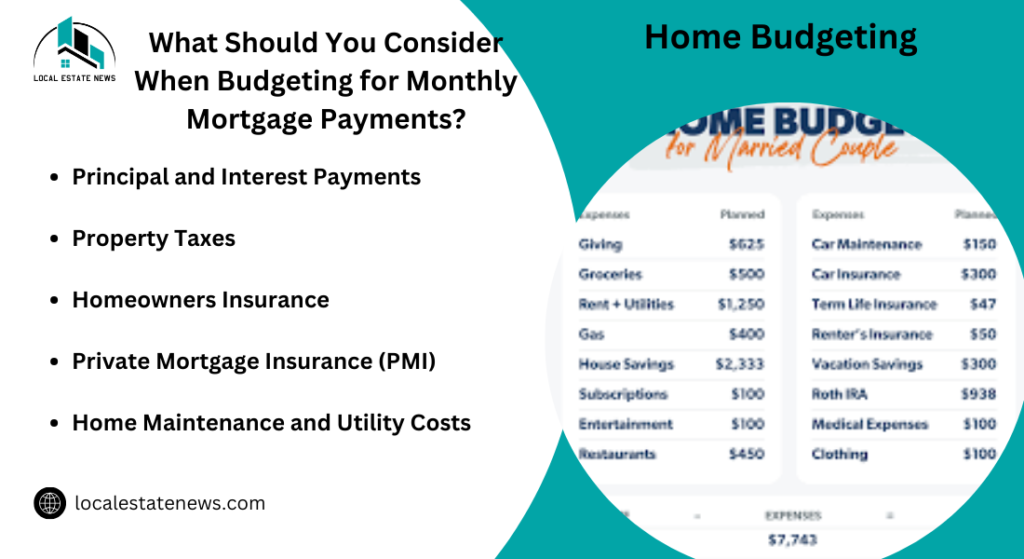
What Assistance Programs are Available for First-Time Homebuyers?
National Assistance Programs
Several national programs are designed to help first-time homebuyers make their dream of homeownership a reality. Programs the FHA Loan offer low down payment options, making it easier for buyers with moderate incomes or limited savings to purchase a home. Popular program is the VA Loan, which provides zero-down payment options for veterans and active-duty military personnel. The USDA Loan is available for buyers in rural areas, offering low-interest rates and no down payment requirements, though eligibility depends on income and property location.
State and Local Assistance Programs
Many states and local governments offer their own first-time homebuyer programs, which often include down payment assistance, reduced interest rates, and tax credits. For instance, the National Homebuyers Fund provides down payment assistance that can cover up to 5% of the mortgage loan amount, helping reduce the upfront costs associated with buying a home. Each state may have specific programs tailored to different populations, low-income families, first responders, or teachers.
Forgivable Loans and Grants
Some states provide forgivable loans, which do not need to be repaid if the buyer remains in the home for a specified period, usually between 5 to 10 years. These programs help reduce the financial burden on first-time buyers and encourage long-term homeownership. Various grants are available that can be used toward down payments and closing costs, providing much-needed financial assistance to those entering the housing market for the first time.
How Do Real Estate Market Trends Affect Home Prices?
Supply and Demand Dynamics
The real estate market is heavily influenced by the basic economic principles of supply and demand. When the demand for homes exceeds the available supply, prices tend to rise. Conversely, when there is an oversupply of homes, prices may decrease. Market conditions, population growth, employment rates, and consumer confidence can drive demand, while factors like construction rates and housing policies impact supply.
Interest Rates and Affordability
Mortgage interest rates are another critical factor affecting home prices. Lower interest rates generally make borrowing cheaper, increasing home buyers‘ purchasing power and driving up demand, which can lead to higher home prices. On the other hand, rising interest rates can reduce affordability, cooling demand and potentially stabilizing or lowering home prices.
Economic Indicators
Wider economic trends, inflation, GDP growth, and unemployment rates, also play a significant role in the housing market. For example, during periods of economic expansion, home prices tend to rise due to higher consumer spending and borrowing capacity. During economic downturns, home prices might stagnate or fall as demand weakens.
How to Balance Lifestyle Choices with Home Affordability?
Prioritizing Location and Amenities
When balancing lifestyle choices with home affordability, it’s essential to prioritize what aspects of your lifestyle are most important. If proximity to work, quality schools, or access to amenities like parks and restaurants is a priority, you may need to adjust your home buying budget accordingly. If space and privacy are more important, you might consider looking in more affordable, less central locations.
Budgeting for Future Needs
Consider how your lifestyle might change over time and how that will impact your housing needs. If you plan to start a family, you may need a home with more space, which could be more expensive. Balancing these future needs with your current budget can help ensure that your home remains affordable over the long term .
Compromising on Non-Essentials
It is also helpful to differentiate between essential and non-essential features. For example, while having a home office might be desirable, it might not be necessary if it pushes you beyond your budget. Being flexible and willing to compromise on certain lifestyle factors, you can find a home that meets your needs without overstretching your finances.
What Are the Long-Term Financial Implications of Stretching Your Budget for a Home?
Increased Financial Stress
Stretching your budget to afford a more expensive home can lead to significant financial stress over the long term. Higher monthly mortgage payments may limit your ability to save for emergencies, retirement, or other financial goals. This can create a situation where you are “house poor,” meaning that a large portion of your income is tied up in homeownership costs, leaving little room for other necessary or unexpected expenses. This financial strain can lead to increased anxiety and reduced financial flexibility, making it challenging to handle life’s uncertainties.
Potential for Greater Debt Accumulation
When you stretch your budget to buy a home, you may be forced to rely more heavily on credit for other purchases, leading to greater debt accumulation. This can result in higher interest payments over time and can make it more difficult to pay down existing debt. If the housing market declines or if you face financial difficulties job loss, you may find yourself struggling to meet mortgage payments, potentially leading to foreclosure or the need to sell the home at a loss.
Impact on Long-Term Wealth Building
Overextending your budget can also impact your ability to build long-term wealth. Committing too much of your income to housing costs, you might have less money to invest in other assets, retirement accounts, stocks, or other investment opportunities. This could mean missing out on the compounding growth of investments, resulting in a smaller retirement fund or less financial security in later life. The lack of liquidity could mean you are less prepared for major life events that require substantial financial resources.
In conclusion, while stretching your budget to buy a more expensive home might seem like a good idea in the short term, the long-term financial implications can be significant. It is essential to carefully consider these factors and ensure that your home purchase aligns with your broader financial goals and long-term security.
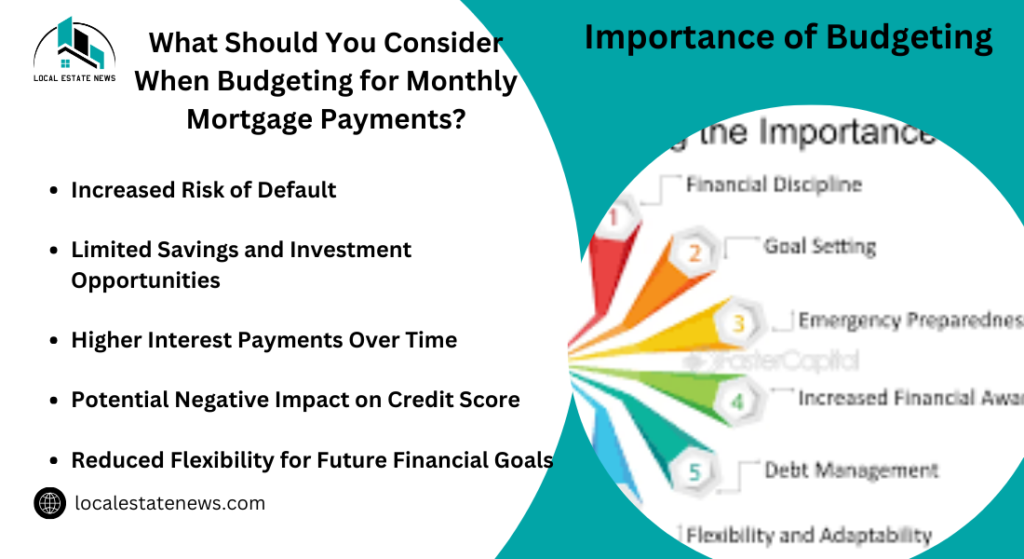
How Can You Plan for Future Housing Market Fluctuations?
Diversify Your Investment Portfolio
The best way to prepare for potential housing market fluctuations is to diversify your investment portfolio. By spreading your investments across different asset classes stocks, bonds, and real estate, you can reduce your risk. If the housing market experiences a downturn, the impact on your financial health might be mitigated by the performance of other investments. This approach helps balance the inherent risks in real estate with more stable or counter-cyclical assets.
Build and Maintain an Emergency Fund
An emergency fund is crucial for weathering financial storms caused by housing market fluctuations. Ideally, this fund should cover 3 to 6 months of living expenses, including mortgage payments. Having a robust emergency fund ensures that you can maintain your mortgage payments and avoid foreclosure or forced sales during economic downturns or periods of high interest rates. It also provides a buffer against unexpected costs related to homeownership, repairs or property tax increases.
Consider Fixed-Rate Mortgages
Choosing a fixed-rate mortgage over an adjustable-rate mortgage (ARM) can provide financial stability in the face of housing market fluctuations. Fixed-rate mortgages lock in your interest rate for the life of the loan, protecting you from future increases in interest rates that could make monthly payments unaffordable. This predictability can help you better manage your long-term financial planning and avoid the financial strain that might come with fluctuating interest rates.
Stay Informed and Monitor Market Conditions
Regularly monitoring real estate trends and economic indicators can help you anticipate potential market fluctuations. Pay attention to factors interest rates, housing supply and demand, employment rates, and broader economic conditions. Staying informed allows you to make timely decisions, refinancing your mortgage or selling a property before a market downturn, which can protect your financial interests.
Plan for Long-Term Homeownership
planning for long-term homeownership rather than short-term gains can help mitigate the impact of market fluctuations. Real estate is a long-term investment, and holding onto your property through various market cycles can allow you to ride out temporary downturns and potentially benefit from long-term appreciation. That your home is affordable based on your income and financial situation, even during challenging economic times, is key to maintaining stability and building equity over time
What Are the Key Takeaways for Ensuring Long-Term Home Affordability?
Long-term home affordability requires careful planning and consideration of multiple factors, from understanding the impact of mortgage rates and credit scores to assessing the potential risks of overextending your budget. Taking a proactive approach diversifying your investments, building an emergency fund, and choosing stable mortgage options you can better prepare for the uncertainties of the housing market and protect your financial future. Real estate terms
It is also essential to stay informed about real estate trends and economic conditions, allowing you to make timely decisions that align with your long-term goals. Planning for long-term homeownership, rather than short-term gains, that you can weather market fluctuations. An incorporating these strategies, you can navigate the complexities of the housing market with confidence and secure a home that remains affordable and sustainable throughout the years.



